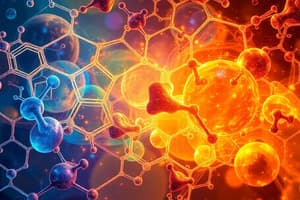Podcast
Questions and Answers
¿Qué tipo de compuestos se forman cuando un metal reacciona con oxígeno?
¿Qué tipo de compuestos se forman cuando un metal reacciona con oxígeno?
- Peróxidos (correct)
- Sales binarias
- Hidróxidos
- Hidruros
¿Qué tipo de compuestos son los hidruros?
¿Qué tipo de compuestos son los hidruros?
- Compuestos iónicos
- Compuestos binarios (correct)
- Compuestos complejos
- Compuestos ternarios
¿Cuál es un ejemplo de un hidruro volátil formado por silicio?
¿Cuál es un ejemplo de un hidruro volátil formado por silicio?
- Hidruro de silicio (SiH4) (correct)
- Hidruro de carbono (CH4)
- Hidruro de fósforo (PH3)
- Hidruro de nitrógeno (NH3)
¿Qué tipo de compuestos se forman cuando un metal reacciona con agua?
¿Qué tipo de compuestos se forman cuando un metal reacciona con agua?
¿En qué estado se encuentra el titanio en el dióxido de titanio (TiO2)?
¿En qué estado se encuentra el titanio en el dióxido de titanio (TiO2)?
¿Cuál de las siguientes afirmaciones es verdadera sobre las sales binarias?
¿Cuál de las siguientes afirmaciones es verdadera sobre las sales binarias?
¿Qué metal reacciona con oxígeno para formar peróxido?
¿Qué metal reacciona con oxígeno para formar peróxido?
¿Cómo se puede equilibrar la siguiente reacción química: Mg + O2 → MgO?
¿Cómo se puede equilibrar la siguiente reacción química: Mg + O2 → MgO?
¿Cuál de las siguientes afirmaciones describe mejor la formación de hidruros?
¿Cuál de las siguientes afirmaciones describe mejor la formación de hidruros?
¿Cuál de las siguientes opciones describe mejor la formación de óxidos?
¿Cuál de las siguientes opciones describe mejor la formación de óxidos?
Study Notes
Chemical Reactions: Formulation and Reactions of Inorganic Compounds
Chemical reactions involve the rearrangement of atoms or molecules to form a different set of atoms or molecules. These reactions can form a wide variety of inorganic compounds, including hydroxides, oxides, hydrides, binary salts, peroxides, and other complex compounds. In this article, we will explore the formation and reactions of these inorganic compounds, focusing on their role in various scientific and technological fields.
Formulation of Hydroxides
Hydroxides are ternary ionic compounds made up of a metal and an element from the hydroxy group. They are formed when a metal reacts with water, producing a metal cation and hydroxide anion. For example, magnesium reacts with water to form magnesium hydroxide (Mg(OH)2).
Formulation of Oxides
Oxides are formed when a metal reacts with oxygen, typically in the presence of heat. They can contain the metal in its highest oxidation state. For instance, titanium dioxide (TiO2) contains titanium in its highest oxidation state (+4) and can act as an oxidant by accepting electrons.
Formulation of Hydrides
Hydrides are binary combinations of a metal and hydrogen. They can be classified as volatile hydrides, which are made up of hydrogen plus one of the elements such as nitrogen, phosphorus, arsenic, antimony, carbon, silicon, and boron. For example, silicon hydride (SiH4) is a volatile hydride made up of silicon and hydrogen.
Formulation of Binary Salts
Binary salts are the combination of two elements other than hydrogen and oxygen. They can be neutral salts, formed when a metallic and a non-metallic element unite, or volatile salts, formed when two non-metallic elements combine. For example, sodium chloride (NaCl) is a neutral salt made up of sodium and chlorine, while carbon dioxide (CO2) and water (H2O) form a volatile salt when they react to form carbonic acid.
Formulation of Peroxides
Peroxides are made up of certain metals plus binary combinations of oxygen (peroxide ion). They are most commonly formed by the alkali and alkaline earth metals, which react with oxygen to form peroxides. For example, sodium peroxide (Na2O2) is formed when sodium reacts with oxygen.
Chemical Reaction Balancing
Balancing chemical reactions is an essential part of understanding chemical principles. It involves ensuring that the number of atoms of each element is the same on both sides of the equation. For example, the reaction between magnesium and oxygen to form magnesium oxide can be balanced as follows:
Mg + O2 → MgO
The balanced equation indicates that one molecule of magnesium reacts with one molecule of oxygen to form one molecule of magnesium oxide.
In conclusion, chemical reactions play a crucial role in the formation and reactions of various inorganic compounds, including hydroxides, oxides, hydrides, binary salts, peroxides, and other complex compounds. These compounds have numerous applications in fields such as chemistry, electronics, energy, medicine and pharmacy, catalysts, glass and ceramics industry, and textile industry. Understanding the principles of chemical reactions and the formulation of these inorganic compounds is essential for developing new materials and technologies.
Studying That Suits You
Use AI to generate personalized quizzes and flashcards to suit your learning preferences.
Description
Explora la formulación y reacciones de compuestos inorgánicos como hidróxidos, óxidos, hidruros, sales binarias y peróxidos. Aprende sobre su formación, características y aplicaciones en diversos campos científicos y tecnológicos.




